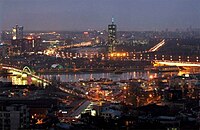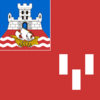New Belgrade
|
New Belgrade Нови Београд Novi Beograd |
|||
|---|---|---|---|
| Urban neighborhood and municipality | |||

New Belgrade by night
|
|||
|
|||
 Location of Lazarevac within the city of Belgrade |
|||
 Location of the city of Belgrade within Serbia |
|||
| Country |
|
||
| City | Belgrade | ||
| Status | Municipality | ||
| Settlements | 1 | ||
| Government | |||
| • Type | Municipality of Belgrade | ||
| • Mun. president | Aleksandar Šapić (Ind.) | ||
| Area | |||
| • Total | 40.74 km2 (15.73 sq mi) | ||
| Population (2011) | |||
| • Total | 212,104 | ||
| • Density | 5,200/km2 (13,000/sq mi) | ||
| Time zone | CET (UTC+1) | ||
| • Summer (DST) | CEST (UTC+2) | ||
| Postal code | 11070 | ||
| Area code(s) | +381(0)11 | ||
| Car plates | BG | ||
| Website | www |
||
New Belgrade (Serbian: Нови Београд / Novi Beograd, pronounced [nôʋiː beǒɡrad]) is an urban neighborhood and one of 17 city municipalities that constitute the city of Belgrade, the capital of Serbia. It is Central business district in Serbia and one of major in Southeast Europe. In the was planned municipality, built since 1948 in a previously uninhabited area on the left bank of the Sava River, opposite the old Belgrade. In recent years it has become the central business district of Belgrade and its fastest developing area, with many businesses moving to the new part of the city, due to more modern infrastructure and larger available space. With 212,104 inhabitants, it is the second most populous municipality of Serbia after Novi Sad.
Bežanija is the oldest part of today's New Belgrade, where a settlement existed from the neolithic to the Roman period.
In the book Kruševski pomenik from 1713, which is kept in the Dobrun monastery near Višegrad, settlement of Bežanija was mentioned for the first time under its present name as far as 1512, as a small village with 32 houses, populated by Serbs. In this time, the village was under the administration of the medieval Kingdom of Hungary, and was part of the Syrmia County. The inhabitants of the village crossed the Sava river and settled in Syrmia after fleeing the fall of the medieval Serbian Despotate under the hands of the Ottoman Empire (hence the name bežanija, "refugee camp" in archaic Serbian).
...
Wikipedia


